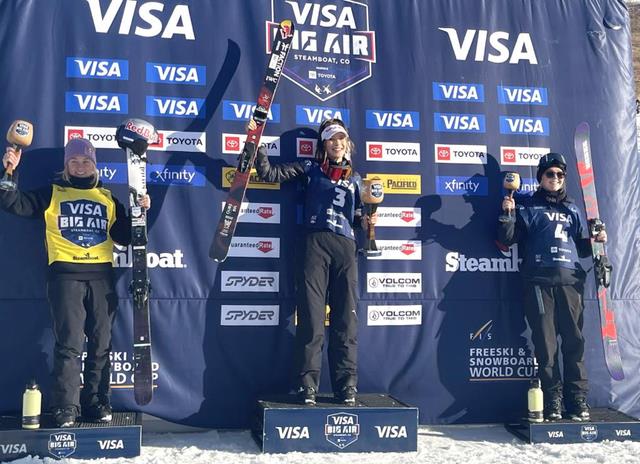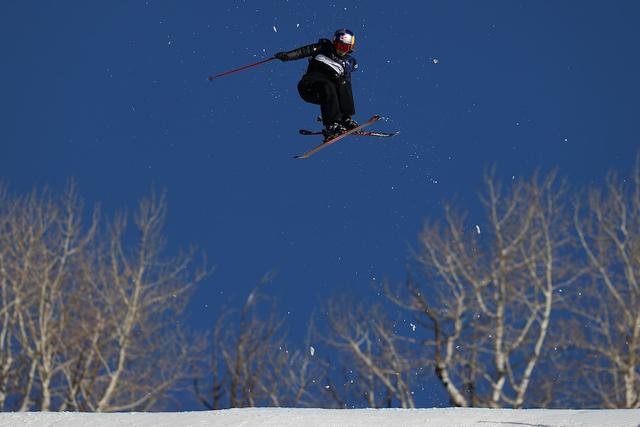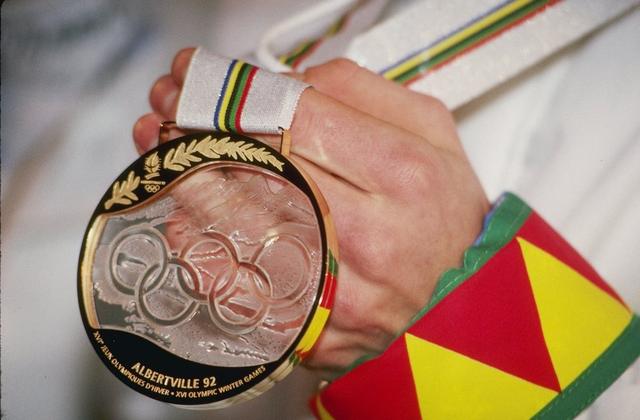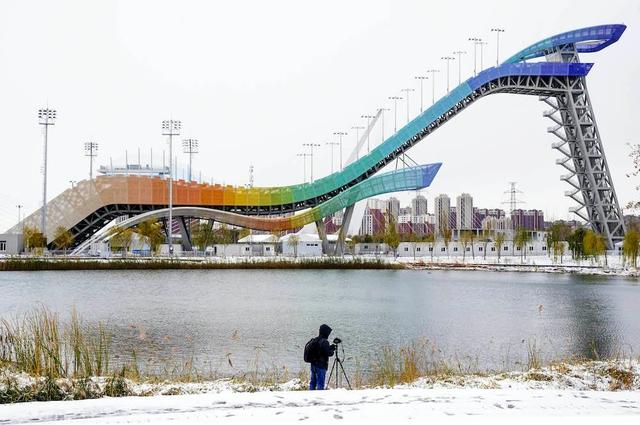What should I do if I don’t understand freestyle skiing? Please accept this "literacy" guide.
In the early morning of December 5th, Beijing time, in the 2021/22 FISHEF World Cup freestyle skiing and snowboarding (Big Air) in Stembot, USA, Gu Ailing, an 18-year-old from China, completed the Double Cork 1440-degree (two-week somersault+twist), becoming the first woman in the world to complete this movement, making history and winning the freestyle skiing platform project.
In the snowboarding platform event, 17-year-old China teenager Su Yiming (who once played "Little Embolden" in the play "Taking the Tiger Mountain Outward") performed well. He won the championship with a total score of 155.265 for the first time in the World Cup finals, becoming the first China athlete to win the snowboarding platform event.

Gu Ailing at the award ceremony Xinhua News Agency This is not the first time freestyle skiing has entered the public eye.In the past two years, Gu Ailing has gradually emerged in the audience’s sight in China, and has won many championships in freestyle skiing U-shaped venue skills and slope obstacle skills in Lausanne Winter Youth Olympic Games and X Games Extreme Games in the United States. In addition, at the 2006 Winter Olympics in Turin, Han Xiaopeng won the first gold medal of China men’s athletes in this event. Li Nina, Xu Mengtao and other female athletes also competed for gold and silver in major events such as the World Championships and the Olympic Games, creating great achievements.
However, compared with traditional ice and snow events such as short track speed skating and figure skating, the public’s understanding of freestyle skiing is still less.
In fact, China has always been a traditional strong team in freestyle skiing aerial skills, and it will be one of the most anticipated hot events to win gold at the Beijing Winter Olympics in two months.

Gu Ailing was in the big platform competition in the United States. Vision china diagramFreestyle Skiing,Is a young sport, its history can be traced back to the early 20th century. At that time, Norway, Austria and other ski countries had a group of thrill-seeking enthusiasts who tried to jump and spin on heavy skis.The real rise of freestyle skiing was in the United States in the 1960s. At that time, with the social movement, the trend of pursuing freedom was widely spread among young people. The progress of science and technology and the emergence of new materials also gradually enhanced the maneuverability and flexibility of snowboarding, and playing all kinds of "fancy" became a trend in the snow field.

In 1992, freestyle skiing officially became one of the events in the Albertville Winter Olympics, but only snow skills were available at that time. In the history of vision china, the first freestyle skiing competition was held in 1966 in New Hampshire, USA. In 1979, freestyle skiing was officially recognized as a separate event by the International Skiing Federation (FIS). In the 1990s, it began to enter the Winter Olympics. In recent Winter Olympics, freestyle skiing has become an official event.At the Beijing Winter Olympics, freestyle skiing will be divided into six events, including snow skills, aerial skills, slope obstacle skills, obstacle pursuit, U-shaped field skills and big platform, and 13 gold medals will be born.Except for Gu Ailing’s gold medal-winning platform project, which was held in Shougang Snow Platform in Beijing, other projects were held in Genting Ski Park in Chongli District, Zhangjiakou City.

Shougang ski platform is the first permanent platform in the world, and it is also the first competition venue combined with industrial heritage in the history of Winter Olympics. The inspiration of modeling design comes from the "flying" image of Dunhuang. The steel structure design of the platform also reserves the possibility of coping with the changes in demand of different events in the future. It is worth mentioning that freestyle skiing refers specifically to snowboarding, which is different from snowboarding, which also includes four events, such as slope obstacle skills, obstacle pursuit, U-shaped field skills and big platform, but there are no snow skills and aerial skills.

U-shaped venue of Genting Ski Park official website map of Genting Ski ResortSnow skill (Mogul)Our competition venues are generally built on steep slopes, which are composed of steep slope lines composed of many snow mounds. This kind of snow mound terrain is also called "cat jumping" skiing or "sliding mushroom" in China, which originated from a natural terrain formed by many skiers after natural snowfall. The snow skill track of the competition is made up of manual accumulation and rest. There are two jumping points in the track, and the players need to complete two jumps in the process of downhill along the snow Bao Dao.

Snow skill competition venues are generally built on steep slopes, which are composed of steep slope lines composed of many snow mounds. Vision china diagramAerial skill (aerial)In the event, the athletes jump through the steep jumping platform, and they need to complete various somersaults and turns before landing. In 1928, Carlton of the United States became the first athlete in the world to complete the snow somersault on a snowboard. The scoring of aerial skills is mainly concentrated in three parts: take-off, aerial action and landing. The score of a trial jump is the quality of completion multiplied by the difficulty coefficient of action. Aerial skill is also an early event in China’s ice and snow sports, with strong strength. In history, Guo Dandan, the first ski world champion in China, and famous athletes such as Han Xiaopeng and Li Nina were born.

In aerial skill competitions, players usually do somersaults for 2-3 weeks. Vision china diagram

Han Xiaopeng won the men’s freestyle skiing aerial skill in the 2006 Winter Olympics in Turin. Vision china diagramSlopestyleIt is a fashionable and interesting project, which became an official project at the 2014 Winter Olympics in Sochi. In the slope obstacle skill competition, the contestants need to complete the fancy movements continuously on a series of fixed props, which is what skiers commonly call "playing in the park". Props include all kinds of irons, such as long straight bars and curved bars, as well as boxes and sloping platforms of different sizes.

In 2021, Gu Ailing won the women’s slope obstacle skill final in freestyle skiing world championships. Vision china diagramU-shaped field skill (Half Pipe)The so-called "U-pool" glides down from the inclined semi-cylindrical slope and takes off with the help of the pool walls on both sides, showing aerial movements such as jumping, turning and grasping the board. In a slide, the contestants usually do 5-6 movements, and the referee will score according to the flying height, difficulty, fluency and aesthetics of the movements.

Vision china map of U-shaped venue skill competitionSki CrossIt is the only racing event in freestyle skiing, and it is also a very ornamental and unpredictable event. The contestants set off in groups of four, and passed through a series of complicated and changeable terrain such as "washboard", continuous curve, wave path and platform jumping, and competed for who would reach the finish line first. The top two in each group entered the next round, and the last two were eliminated. In order to seize the leading position and the best sliding route, there will inevitably be physical contact between players, but if you deliberately interfere with other athletes, it will be a foul and will be disqualified.

The competition among the athletes in the obstacle chase competition is fierce and enjoyable. Vision china diagram

On November 27th, 2021, Zhangjiakou, Hebei Province, 21/22 International Snow Federation freestyle skiing obstacle chasing the World Cup. Vision china Tugu Ailing’s freestyle skiing that won the World Cup this time.Big AirIt is a new event in the 2022 Beijing Winter Olympics. Compared with freestyle skiing aerial skills, the aerial action of the big platform pays more attention to creativity and freedom, and athletes often perform difficult performances such as grabbing boards in the air and falling backwards, and the horizontal flight distance will be longer.

The continuous pictures of a big platform jump are superimposed, and players often leap tens of meters horizontally. The freestyle skiing events mentioned above are all carried out in artificially trimmed venues. It also has a twin brother-“Freeride”,Usually refers to the free skiing in the pure natural high Shan Ye snow environment, also known as "Big Shan Ye Snow".Leave the crowded snowy road, enter the vast world where few people come, gallop down from the top of the mountain, enjoy the extreme pleasure of surfing in the powder snow, and draw a wonderful arc in the white world. Snow in Shan Ye is the ultimate pursuit of many skiers.

The World Wild Snow Tour (FWT) starts from the top of the steep mountain. FWT official website diagramBig Shan Ye SnowThere is also its own exclusive competition-FWT (Freeride World Tour) World Wild Snow Tour. From January to March every year, sub-races are held in wild snow resorts around the world, such as the Canadian Rockies, the European Alps, and the Japanese White Horse. The track is a natural snowy hillside.Players need to bypass all kinds of obstacles, such as trees and rocks, leap from the cliff and descend tens of meters, and be creative in the high Shan Ye snow, freely choose the sliding route, and challenge the difficulty limit of terrain and air movements. The referee will judge and score the players through route selection, gliding posture skills, air movements, fluency and other factors. In order to avoid possible avalanche risks, players must also carry three-piece avalanche rescue sets (signal transceiver, probe, snow shovel), avalanche airbag backpacks and other safety equipment. Only the top few wild snow players are eligible to participate in the competition, which can be called the "ceiling" of the wild snow competition.
(This article is from The Paper, please download the "The Paper" APP for more original information)
Reporting/feedback